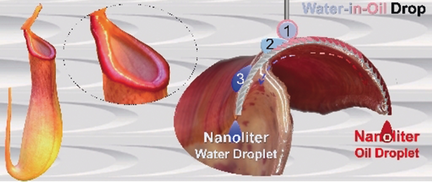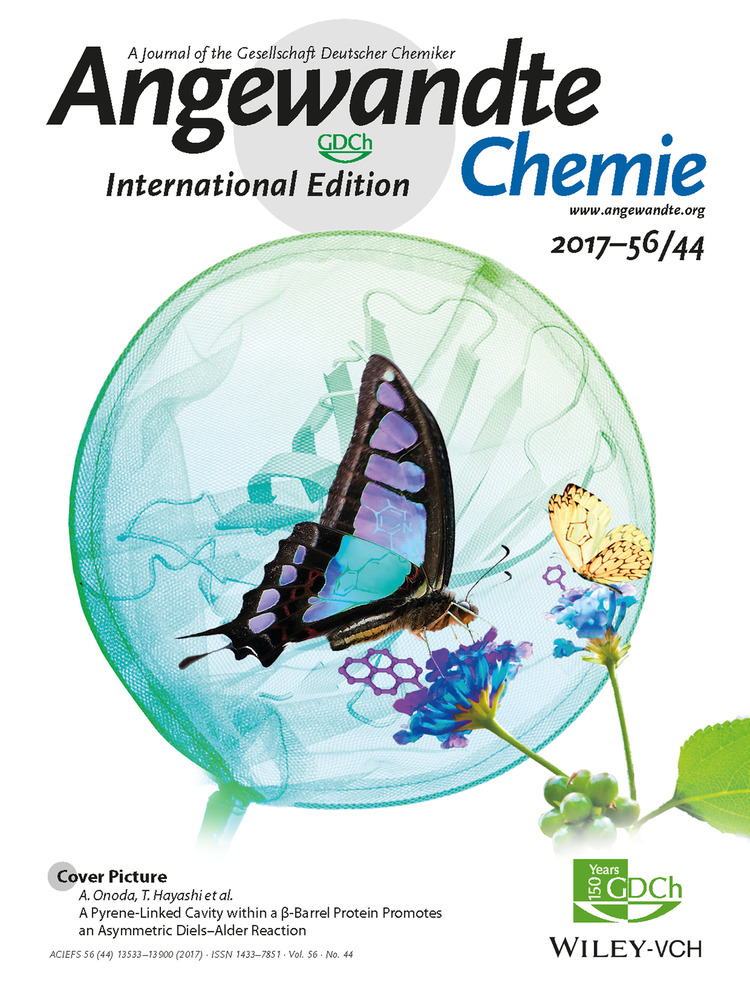Peristome-Mimetic Curved Surface for Spontaneous and Directional Separation of Micro Water-in-Oil Drops
Chuxin Li
CAS Key Laboratory of Bio-inspired Materials and Interface Sciences, Technical Institute of Physics and Chemistry, Chinese Academy of Sciences, Zhongguancun East Road, 29, 100190 Beijing, PR China
School of Future Technology, University of Chinese Academy of Sciences, Yuquan Road, No.19(A), 100049 Beijing, PR China
These authors contributed equally to this work.
Search for more papers by this authorDr. Lei Wu
CAS Key Laboratory of Green Printing, Institute of Chemistry, Chinese Academy of Sciences, Zhongguancun North First Street 2, 100190 Beijing, PR China
These authors contributed equally to this work.
Search for more papers by this authorCunlong Yu
CAS Key Laboratory of Bio-inspired Materials and Interface Sciences, Technical Institute of Physics and Chemistry, Chinese Academy of Sciences, Zhongguancun East Road, 29, 100190 Beijing, PR China
School of Future Technology, University of Chinese Academy of Sciences, Yuquan Road, No.19(A), 100049 Beijing, PR China
Search for more papers by this authorCorresponding Author
Dr. Zhichao Dong
CAS Key Laboratory of Bio-inspired Materials and Interface Sciences, Technical Institute of Physics and Chemistry, Chinese Academy of Sciences, Zhongguancun East Road, 29, 100190 Beijing, PR China
School of Future Technology, University of Chinese Academy of Sciences, Yuquan Road, No.19(A), 100049 Beijing, PR China
Search for more papers by this authorProf. Dr. Lei Jiang
CAS Key Laboratory of Bio-inspired Materials and Interface Sciences, Technical Institute of Physics and Chemistry, Chinese Academy of Sciences, Zhongguancun East Road, 29, 100190 Beijing, PR China
School of Future Technology, University of Chinese Academy of Sciences, Yuquan Road, No.19(A), 100049 Beijing, PR China
Search for more papers by this authorChuxin Li
CAS Key Laboratory of Bio-inspired Materials and Interface Sciences, Technical Institute of Physics and Chemistry, Chinese Academy of Sciences, Zhongguancun East Road, 29, 100190 Beijing, PR China
School of Future Technology, University of Chinese Academy of Sciences, Yuquan Road, No.19(A), 100049 Beijing, PR China
These authors contributed equally to this work.
Search for more papers by this authorDr. Lei Wu
CAS Key Laboratory of Green Printing, Institute of Chemistry, Chinese Academy of Sciences, Zhongguancun North First Street 2, 100190 Beijing, PR China
These authors contributed equally to this work.
Search for more papers by this authorCunlong Yu
CAS Key Laboratory of Bio-inspired Materials and Interface Sciences, Technical Institute of Physics and Chemistry, Chinese Academy of Sciences, Zhongguancun East Road, 29, 100190 Beijing, PR China
School of Future Technology, University of Chinese Academy of Sciences, Yuquan Road, No.19(A), 100049 Beijing, PR China
Search for more papers by this authorCorresponding Author
Dr. Zhichao Dong
CAS Key Laboratory of Bio-inspired Materials and Interface Sciences, Technical Institute of Physics and Chemistry, Chinese Academy of Sciences, Zhongguancun East Road, 29, 100190 Beijing, PR China
School of Future Technology, University of Chinese Academy of Sciences, Yuquan Road, No.19(A), 100049 Beijing, PR China
Search for more papers by this authorProf. Dr. Lei Jiang
CAS Key Laboratory of Bio-inspired Materials and Interface Sciences, Technical Institute of Physics and Chemistry, Chinese Academy of Sciences, Zhongguancun East Road, 29, 100190 Beijing, PR China
School of Future Technology, University of Chinese Academy of Sciences, Yuquan Road, No.19(A), 100049 Beijing, PR China
Search for more papers by this authorGraphical Abstract
Keep 'em separated: A curved surface resembling the peristome, that is, the fringe of small projections around the opening of a capsule of a tropical pitcher plant is prepared. It enables the spontaneous separation of water and oil from micro-scale water-in-oil drops without energy input. The separation occurs within milliseconds and the separated liquids are spontaneously and uni-directionally transported in different directions.
Abstract
Separation of micro-scaled water-in-oil droplets is important in environmental protection, bioassays, and saving functional inks. So far, bulk oil–water separation has been achieved by membrane separation and sponge absorption, but micro-drop separation still remains a challenge. Herein we report that instead of the “plug-and-go” separation model, tiny water-in-oil droplets can be separated into pure water and oil droplets through “go-in-opposite ways” on curved peristome-mimetic surfaces, in milliseconds, without energy input. More importantly, this overflow controlled method can be applied to handle oil-in-oil droplets with surface tension differences as low as 14.7 mN m−1 and viscous liquids with viscosities as high as hundreds centipoises, which markedly increases the range of applicable liquids for micro-scaled separation. Furthermore, the curved peristome-mimetic surface guides the separated drops in different directions with high efficiency.
Supporting Information
As a service to our authors and readers, this journal provides supporting information supplied by the authors. Such materials are peer reviewed and may be re-organized for online delivery, but are not copy-edited or typeset. Technical support issues arising from supporting information (other than missing files) should be addressed to the authors.
| Filename | Description |
|---|---|
| anie201706665-sup-0001-misc_information.pdf1.9 MB | Supplementary |
| anie201706665-sup-0001-Movie.mp414.7 MB | Supplementary |
Please note: The publisher is not responsible for the content or functionality of any supporting information supplied by the authors. Any queries (other than missing content) should be directed to the corresponding author for the article.
References
- 1
- 1aD. S. Sholl, R. P. Lively, Nature 2016, 532, 435–437;
- 1bR. P. Lively, D. S. Sholl, Nat. Mater. 2017, 16, 276–279.
- 2
- 2aT. Arbatan, X. Fang, W. Shen, Chem. Eng. J. 2011, 166, 787–791;
- 2bZ. Chu, Y. Feng, S. Seeger, Angew. Chem. Int. Ed. 2015, 54, 2328–2338; Angew. Chem. 2015, 127, 2358–2368;
- 2cH. Bellanger, T. Darmanin, E. T. de Givenchy, F. Guittard, Chem. Rev. 2014, 114, 2694–2716.
- 3
- 3aJ. Ge, L. A. Shi, Y. C. Wang, H. Y. Zhao, H. B. Yao, Y. B. Zhu, Y. Zhang, H. W. Zhu, H. A. Wu, S. H. Yu, Nat. Nanotechnol. 2017, 12, 434–440;
- 3bZ. G. Xu, Y. Zhao, H. X. Wang, X. G. Wang, T. Lin, Angew. Chem. Int. Ed. 2015, 54, 4527–4530; Angew. Chem. 2015, 127, 4610–4613;
- 3cZ. Y. Wu, C. Li, H. W. Liang, J. F. Chen, S. H. Yu, Angew. Chem. Int. Ed. 2013, 52, 2925–2929; Angew. Chem. 2013, 125, 2997–3001;
- 3dC. P. Ruan, K. L. Ai, X. B. Li, L. H. Lu, Angew. Chem. Int. Ed. 2014, 53, 5556–5560; Angew. Chem. 2014, 126, 5662–5666;
- 3eH. Hu, Z. Zhao, Y. Gogotsi, J. Qiu, Environ. Sci. Technol. Lett. 2014, 1, 214–220;
- 3fY. L. Zhang, S. Wei, F. J. Liu, Y. C. Du, S. Liu, Y. Y. Ji, T. Yokoi, T. Tatsumi, F. S. Xiao, Nano Today 2009, 4, 135–142;
- 3gC. R. Crick, J. A. Gibbins, I. P. Parkin, J. Mater. Chem. A 2013, 1, 5943–5948.
- 4
- 4aK. Li, J. Ju, Z. X. Xue, J. Ma, L. Feng, S. Gao, L. Jiang, Nat. Commun. 2013, 4, 2276;
- 4bD. Fragouli, A. Athanassiou, Nat. Nanotechnol. 2017, 12, 406–407.
- 5
- 5aJ. Z. Wang, Z. H. Zheng, H. W. Li, W. T. S. Huck, H. Sirringhaus, Nat. Mater. 2004, 3, 171–176;
- 5bL. Wu, Z. C. Dong, M. X. Kuang, Y. A. Li, F. Y. Li, L. Jiang, Y. L. Song, Adv. Funct. Mater. 2015, 25, 2237–2242;
- 5cZ. C. Dong, J. Ma, L. Jiang, ACS Nano 2013, 7, 10371–10379.
- 6B. Wang, W. X. Liang, Z. G. Guo, W. M. Liu, Chem. Soc. Rev. 2015, 44, 336–361.
- 7
- 7aH. J. Cho, D. J. Preston, Y. Zhu, E. N. Wang, Nat. Rev. Mater. 2016, 2, 16092;
- 7bM. J. Kreder, J. Alvarenga, P. Kim, J. Aizenberg, Nat. Rev. Mater. 2016, 1, 15003.
- 8T. S. Wong, S. H. Kang, S. K. Y. Tang, E. J. Smythe, B. D. Hatton, A. Grinthal, J. Aizenberg, Nature 2011, 477, 443–447.
- 9X. L. Liu, J. Gao, Z. X. Xue, L. Chen, L. Lin, L. Jiang, S. T. Wang, ACS Nano 2012, 6, 5614–5620.
- 10C. X. Li, N. Li, X. S. Zhang, Z. C. Dong, H. W. Chen, L. Jiang, Angew. Chem. Int. Ed. 2016, 55, 14988–14992; Angew. Chem. 2016, 128, 15212–15216.
- 11H. W. Chen, P. F. Zhang, L. W. Zhang, H. L. L. Iu, Y. Jiang, D. Y. Zhang, Z. W. Han, L. Jiang, Nature 2016, 532, 85.
- 12Y. Zhang, F. Zhang, Z. Yan, Q. Ma, X. Li, Y. Huang, J. A. Rogers, Nat. Rev. Mater. 2017, 2, 17019.
- 13T. Trantidou, Y. Elani, E. Parsons, O. Ces, Microsyst. Nanoeng. 2017, 3, 16091.
- 14P.-G. De Gennes, F. Brochard-Wyart, D. Quéré, Capillarity and wetting phenomena: drops, bubbles, pearls, waves, Springer Science & Business Media, Amsterdam, 2013.
- 15
- 15aF. Hauksbee, Philos. Trans. R. Soc. London 1712, 27, 395;
10.1098/rstl.1710.0036 Google Scholar
- 15bB. Taylor, Philos. Trans. R. Soc. London 1712, 27, 538.
10.1098/rstl.1710.0070 Google Scholar
- 16
- 16aP. Concus, R. Finn, Appl. Math. Sci. 1969, 63, 292–299;
- 16bR. Finn, Notices of the AMS 1999, 46, 770–781;
- 16cF. J. Higuera, A. Medina, A. Linan, Phys. Fluids 2008, 20, 102102;
- 16dA. Ponomarenko, D. Quéré, C. Clanet, J. Fluid Mech. 2011, 666, 146–154.
- 17
- 17aT. Y. Liu, C. J. Kim, Science 2014, 346, 1096–1100;
- 17bA. Tuteja, W. Choi, M. L. Ma, J. M. Mabry, S. A. Mazzella, G. C. Rutledge, G. H. McKinley, R. E. Cohen, Science 2007, 318, 1618–1622.
- 18S. Yang, J. X. Du, M. Y. Cao, X. Yao, J. Ju, X. Jin, B. Su, K. S. Liu, L. Jiang, Angew. Chem. Int. Ed. 2015, 54, 4792–4795; Angew. Chem. 2015, 127, 4874–4877.
- 19Z. C. Dong, L. Wu, J. F. Wang, J. Ma, L. Jiang, Adv. Mater. 2015, 27, 1745–1750.





